Key Points:
- This guide will help you identify some of the most common black snakes with yellow stripes that can be found in yards and gardens in the U.S.
- Each snake is categorized by its common identification markings, habitat, region, diet, and danger level.
- The plains/eastern garter snake (also known as the garden snake), striped racer (also called California whipsnake), common/California kingsnake, ringneck snake, and coral snake are all included in this guide.
As we inch closer to spring and summer, there is one thing that is sure to come slithering our way — snakes! Snakes come out of hiding during the warmer months and are most often seen during the spring and summer seasons. For many, this is a scary time, especially for people with ophidiophobia. Others, however, may find it incredibly exciting.
Identifying snakes is a hobby that many share, but it isn’t always the easiest. Today, we are going to be looking through most of the common black snakes with yellow stripes in order to help you identify what you may have found in your backyard.
Identifying Black Snakes With Yellow Stripes
There are quite a few species of snakes across the United States, let alone the world. With so many snakes all over, it’s hard to have such a general guide. Still, we are going to cover some of the most common snakes that are black and have yellow stripes.
Below, we have broken down each snake into categories. They include:
- common identification markings
- habitat
- region
- diet
- danger level.
If you happen to find a black snake with yellow stripes, this guide will help you find out which species you have stumbled across!
Garter Snake
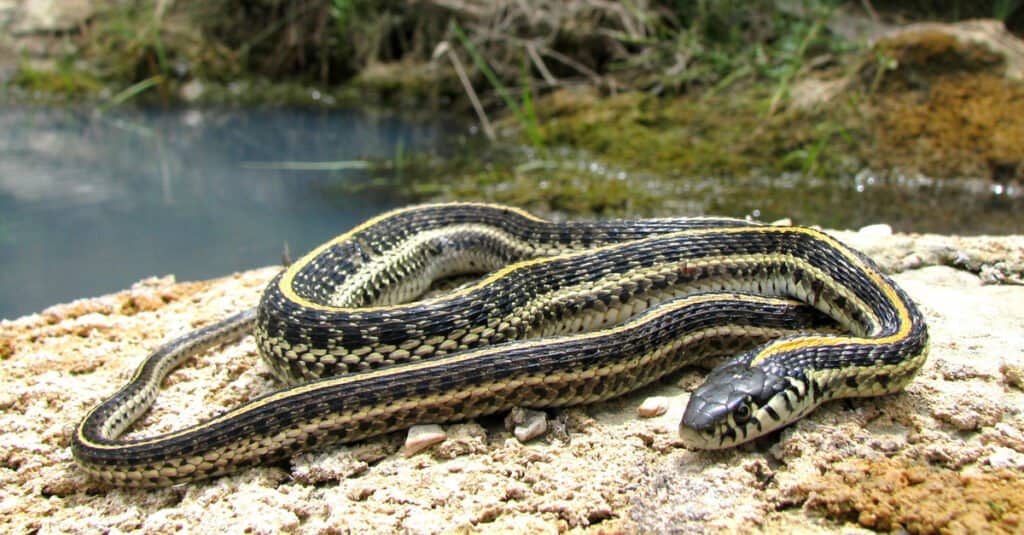
Garter snakes
are known for their latitudinal yellow stripes.
©Joe Farah/Shutterstock.com
Garter snakes are some of the most common snakes in the US. They are sometimes called “garden snakes” because of their name and habit of ending up in the backyard. These snakes aren’t dangerous, and you are likely to encounter them at some point.
Identification: Usually dark-bodied with cream bellies, (usually) yellow stripes running from the base of the head to tail, under 4 feet long.
Habitat: Almost anywhere. Backyards, gardens, swamps, lakes, ponds, mountains, and more.
Region: All over the US. Populated, suburban, rural, and everywhere in between.
Diet: Small mammals, amphibians, earthworms, minnows.
Danger level: Mildly venomous — doesn’t hurt humans aside from swelling. Secretes foul-smelling odor when threatened.
Orange-Striped Ribbon Snake
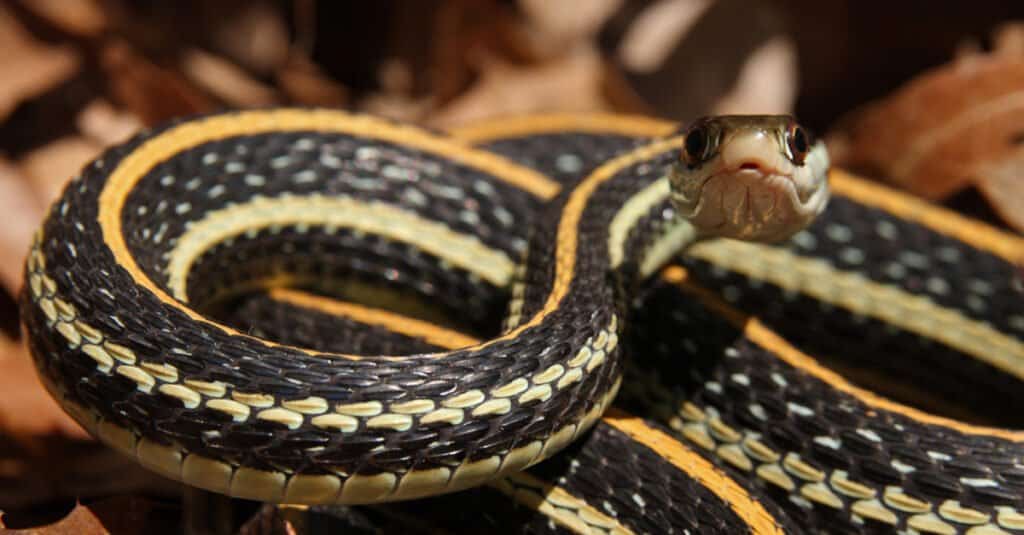
The orange
ribbon snake
is sometimes known as the western garter snake.
©Ryan M. Bolton/Shutterstock.com
Although these are a type of garter snakes, the orange-striped ribbon snake is a perfect fit for our description today. As a result, we did a deeper dive into this specific sub-species.
Identification: Dark-colored, black or brown, yellow stripes running from the base of the head to tail, often have a yellow or orange spot on the back of the head, cream belly.
Habitat: Usually found near water, swamps, marshes, woods, ponds, streams, and rivers.
Region: Most of the United States (most common in western states), Mexico.
Diet: Frogs, toads, salamanders, minnows.
Danger level: Mildly venomous — doesn’t hurt humans aside from swelling, does secrete odor when threatened (stinky but not dangerous).
Striped Racers
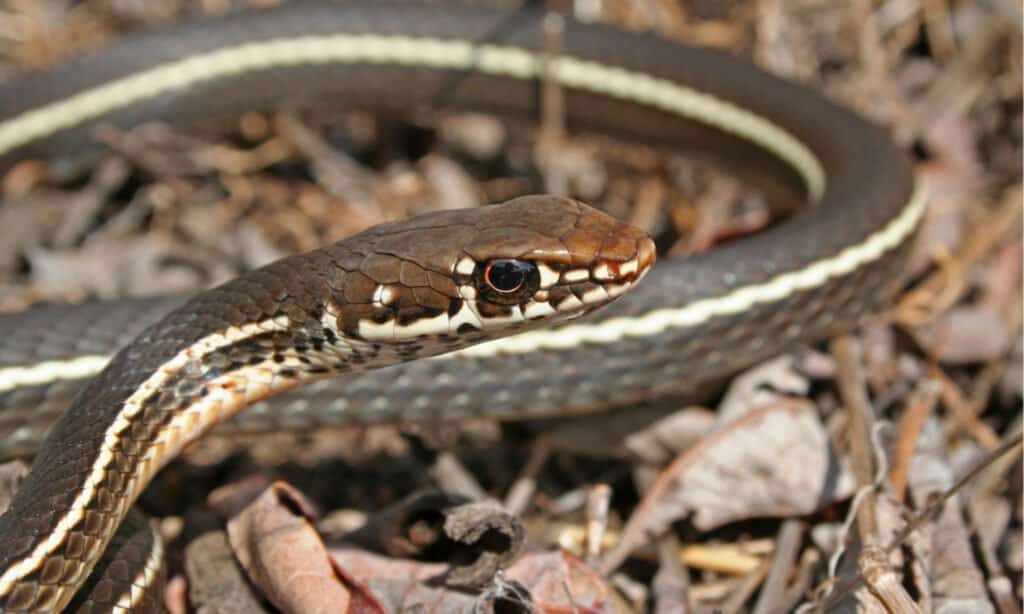
©Creeping Things/Shutterstock.com
Striped racers, often referred to as California whipsnakes, fit the description, while eastern racers don’t. Although they share a name, eastern racers are a different category of snake taxonomically.
Identification: Black or grey bodies with lateral yellow or white stripes running laterally from head to tail. Holds head up while moving. Orange or yellow bellies, small dots under the head.
Habitat: Scrubland, woodland, rocks, foothills.
Region: California and the western US.
Diet: frogs, salamanders, lizards, snakes, birds, rodents, insects
Danger level: Low. Non-venomous, but will strike if cornered.
Common/California Kingsnake

California kingsnakes can come in all sorts of colors, sometimes with yellowish stripes.
©Ann May Snz/Shutterstock.com
There are two species of kingsnake in the US that could potentially match our description of black with yellow stripes; the common and the California kingsnake. These snakes are often kept as pets and now come in a variety of color morphs (specially selected colorations). They get the “king” in their name from their habit of eating other venomous snakes.
Identification:
- Common: Glossy black to dark brown, 20+ white rings around body. Rarely larger than 6 feet in length.
- California: Wide range of color morphs, can be black (or dark) with light bands around body. Can exceed 7 feet in length.
Habitat:
- Common: From the oceans to the mountains and everywhere in between.
- California: From the oceans to the mountains and everywhere in between.
Region:
- Common: Almost all of the continental United States
- California: West coast from Baja to Oregon
Diet:
- Common: Rodents, birds, reptiles, venomous snakes, and almost everything else
- California: Rodents, birds, reptiles, venomous snakes, and almost everything else
Danger level: Low. Non-venomous and often kept as pets.
Ringneck Snake
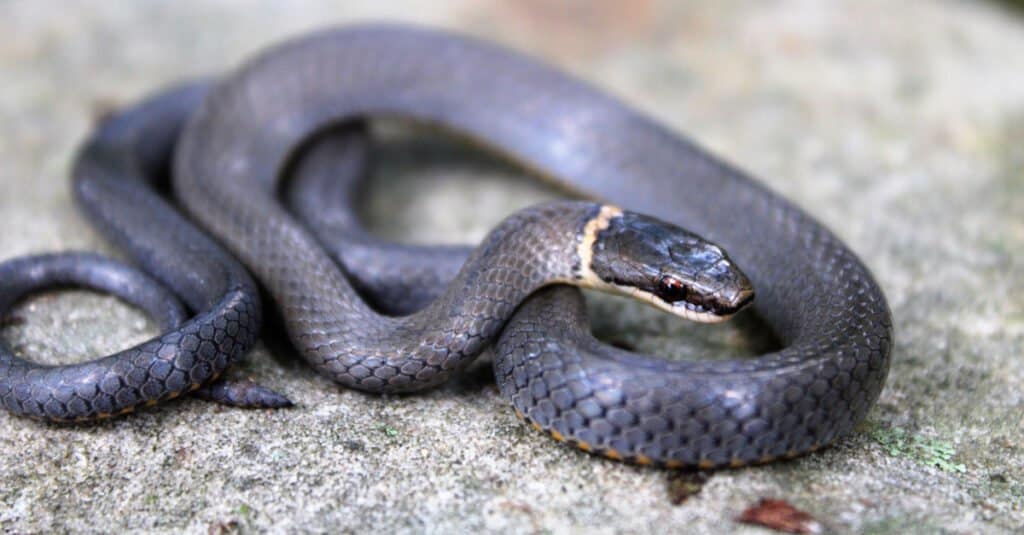
A
ringneck snake
is a beautiful snake with an orange, red, or yellow ring around its neck.
©Tucker Heptinstall/Shutterstock.com
Usually, ringneck snakes are nocturnal and unlikely to be seen by humans. Still, encounters do occasionally happen, but these small snakes are harmless. They are also incredibly beautiful!
Identification: Dark bodies with vibrant underbellies of red or yellow. Small colorful ring of orange or yellow around the neck.
Habitat: Almost everywhere, prefer wooded areas.
Region: Most of the United States, Mexico, and Canada.
Diet: Lizards, snakes, salamanders, frogs, toads, slugs, earthworms
Danger level: Low. Very weak venom that doesn’t impact humans.
Gulf Saltmarsh Snake
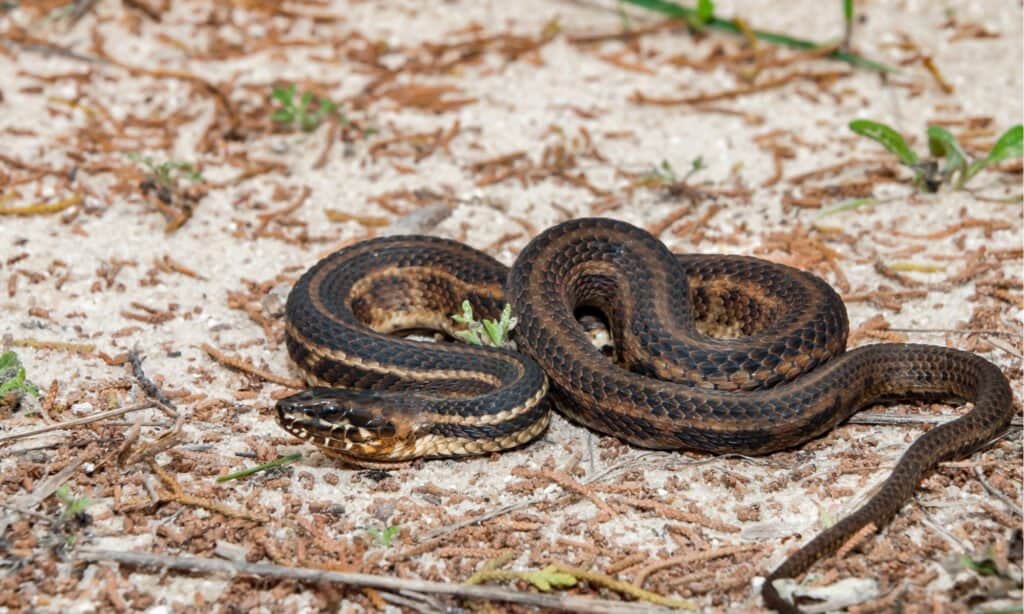
Gulf saltmarsh snakes are often called “salt moccasins”
©Jay Ondreicka/Shutterstock.com
Resembling a water moccasin in some ways, this non-venous snake is sometimes reffed to as a “salt moccasin”. They only live in salt marshes and are currently under threat from habitat destruction.
Identification: Thick black to brown bodies with four stripes running longitudinally from head to tail; two are usually brown while the other two are yellowish.
Habitat: Salt marshes in coastal regions.
Region: Salty marshes from coastal Florida through Texas.
Diet: Small fish, invertebrates, hunt in puddles
Danger level: Low. Non-venomous
Patch-Nosed Snake
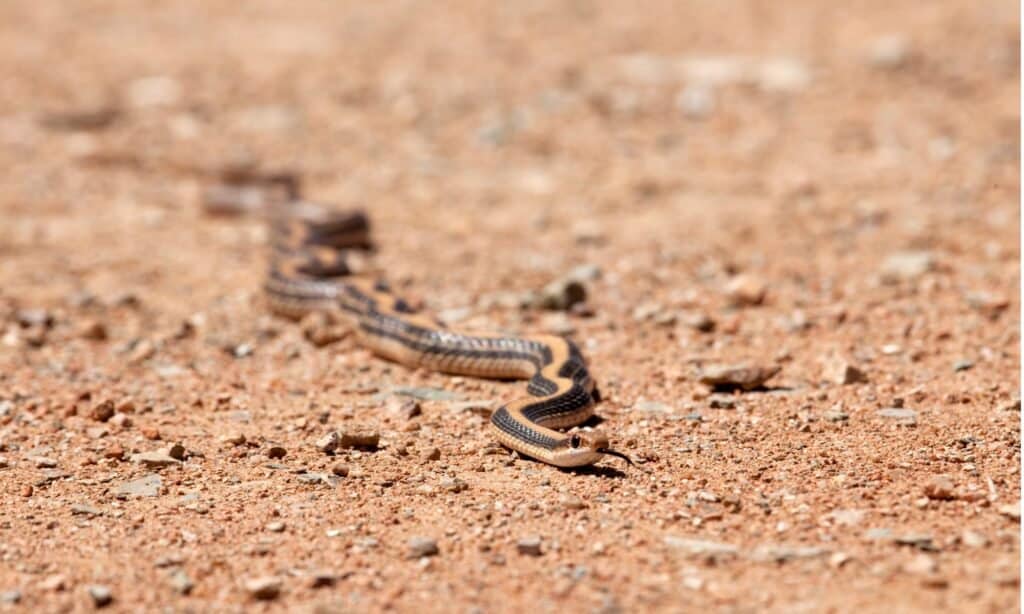
Patch-nosed snakes live in the southwestern United States.
©iStock.com/milehightraveler
Although these snakes usually spend their days under the sand staying cool, they can occasionally be found coming out during cool hours in the morning and evening. Their nose scale is believed to be an adaptation that allows them to slam into the burrows of small mammals through the sand.
Identification: Long, slender bodies. Light tan, cream, brown, or black coloration with tan to yellow-colored stripe running from head to tail down the spine. Large triangular scale on the snout.
Habitat: Desert regions, scrublands, chaparral, canyons
Region: Southwestern United States and into Mexico.
Diet: Lizards, whiptails, birds, small mammals
Danger level: Low. Weak venom that doesn’t impact humans.
Coral Snake

Coral snakes
are highly venomous snakes that should be avoided.
©iStock.com/JasonOndreicka
These snakes are as dangerous as they are beautiful. Despite their name, they don’t swim in the ocean. They should be avoided due to how dangerous their venom can be.
Identification: Long and narrow with black, yellow, and red bands across the body. Always goes black-yellow-red-yellow, with black never touching red.
Habitat: Forests, woodlands, desert scrub, rocky areas, and burrows, all usually near some type of water.
Region: Southern US from Arizona to North Carolina, three different sub-species with the range.
Diet: Snakes, frogs, lizards, birds, small mammals.
Danger level: High. Highly venomous, requiring immediate medical attention.
Yellow-Bellied Sea Snake
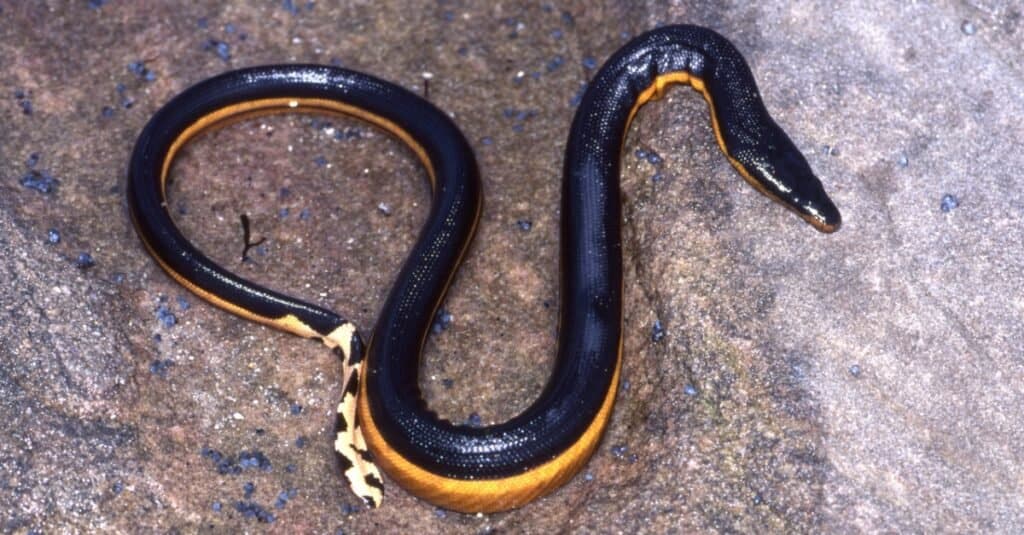
Yellow-bellied sea
snakes only live
in the ocean and are highly dangerous.
©Ken Griffiths/Shutterstock.com
Sea snakes are among the deadliest snakes in the world and the yellow-bellied sea snake is no different. Thankfully, they live their lives in the water and can’t even move on land. Humans only really encounter them while out to sea or when they are accidentally caught in tide pools.
Identification: Streamlines appearance with a tail like a fin. Black bodies with bright yellow bellies that can appear striped when viewed from the side.
Habitat: Lives in and near the sea. Can’t move on land. Occasionally trapped in tide pools.
Region: Hawaii and the coast of California.
Diet: Fish
Danger level: High. Highly venomous, requiring immediate medical attention.
What If the Snake Is Black With White Stripes?
Maybe after closer inspection, you find that the snake has white instead of yellow stripes. We can help you identify which snake that could be, too!
We’ve created a guide to black snakes with white stripes and it can be found here. We suggest checking out the full list, in which each snake is categorized into a few key elements: appearance, range, habitat, diet, and danger level.
Some of the snakes included in the list are the southern black racer, queen snake, and yellow rat snake.
Are Black Snakes Poisonous or Dangerous?
You might well ask this question if you’re getting close to the snake you’re trying to identify. Many of the black snakes in the U.S. are most likely North American rat snakes or black racers, which primarily eat rodents and other small animals.
Black snakes are relatively harmless. They are not poisonous or dangerous and unlikely to attack a human at random — but they may bite if they are confronted or trapped. Generally, they will try to escape at the first sign of danger and typically can swim well.
All snakes can bite as a self-defense mechanism, especially if stepped on by accident. A black snake’s bite can hurt a lot but is not fatal. As the bite contains bacteria, it can lead to infection. It’s best to avoid a situation where a snake might bite. A typical sign that black snakes are uncomfortable is they coil up or bend at unusual, acute angles. Another is that snakes might give off a foul-smelling scent that is dispersed around them with their tail when facing a predator or picked up by a person.
The photo featured at the top of this post is © Creeping Things/Shutterstock.com
Discover the "Monster" Snake 5X Bigger than an Anaconda
Every day A-Z Animals sends out some of the most incredible facts in the world from our free newsletter. Want to discover the 10 most beautiful snakes in the world, a "snake island" where you're never more than 3 feet from danger, or a "monster" snake 5X larger than an anaconda? Then sign up right now and you'll start receiving our daily newsletter absolutely free.
Thank you for reading! Have some feedback for us? Contact the AZ Animals editorial team.






